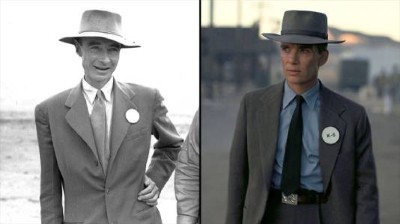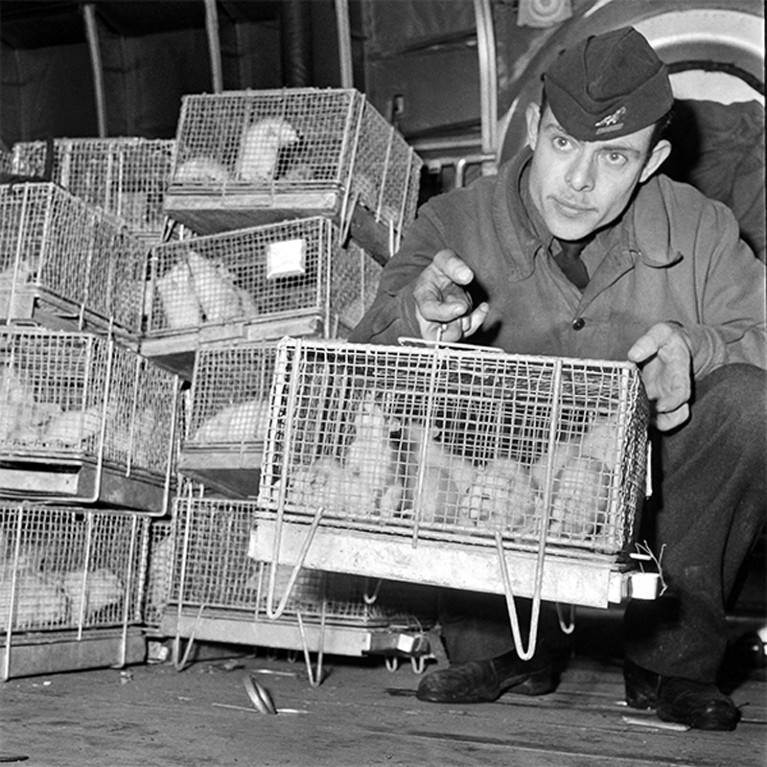A sandstorm cloud enveloping a military camp in Iraq, 2005.Credit: US Department of Defense/Cpl Alicia M. Garcia, US Marine Corps/Reuters
Dust: The Modern World in a Trillion Particles Jay Owens Hodder & Stoughton (2023)
In February 1960, the French government detonated the first of 17 nuclear weapons in tests in Algeria. Being under French rule at the time, Algerians had little say. Thousands of people were exposed to radiation from the explosions, four of which were conducted above ground. The fallout spread across much of northern Africa; deadly particles settled on towns and dunes and blew across the landscape, contaminating the environment and affecting people’s health.
Such toxic intersections of pollution and power form the backbone of Dust, an exploration of “tiny particles doing terrible things”, by media and technology researcher Jay Owens. From coal smoke smothering London in the seventeenth century to pollutants hastening the melting of Greenland’s ice cap today, Dust is a fresh look at the interconnectedness of our planet and our species.
Atomic legacy
Radioactive fallout tops the list of environmental misdeeds. US atomic bombs killed some 200,000 people in the Japanese cities of Hiroshima and Nagasaki to end the Second World War, but a much more devastating legacy came from the nuclear-weapons testing that followed. The United States, Soviet Union and other nations detonated more than 500 nuclear bombs in the atmosphere during the 1950s and 1960s, setting radioactive particles adrift until such tests were prohibited under the 1963 Partial Nuclear Test Ban Treaty. International Physicians for the Prevention of Nuclear War, a federation of medical professionals based in Boston, Massachusetts, has estimated that 2.4 million people died or will die from the effects of this radioactive dust.

Why Oppenheimer has important lessons for scientists today
Those with the least agency are often hit hardest. One UK veteran, whose naval ship was deliberately sent into the blast zone of a nuclear test on the Montebello Islands off the coast of Australia in 1957, told Owens that the falling dust was “like a gentle rain from heaven. But it wasn’t gentle: it was ionising radiation.” People far from the blasts were not spared: on US soil, for instance, decades of uranium mining on Native American lands exposed many families to toxic ore dust that made them ill.
This is the legacy of the dust that humanity has made, Owens argues. It’s fitting that the global rise in plutonium from nuclear testing deposited in rocks and soils is the proposed geological marker for the start of an Anthropocene epoch, the age in which humans are changing the planet.
And dust can be destructive in many other ways. During the 1930s Dust Bowl phenomenon in the midwestern United States, farm fields that had recently been seized from Native Americans and then ploughed up fuelled immense storms of dust. The particles blackened the sky and buried homes in dirt. This disaster drove millions of people away from their homes, in the biggest migration in US history.
Poisoned lakes
Some of the most powerful narratives in the book centre on dried lake beds. California’s Owens Valley lost much of its water starting in the 1910s, when the city of Los Angeles diverted a river to slake its growing thirst. Without water to replenish the basin, what had been a lake became a dry, crusty source of dust, with millions of tonnes of particles blowing off it each year, infiltrating people’s homes and lungs. Today, the valley is the site of a concerted effort to control the dust when conditions get bad, by flooding some areas and adding vegetation and gravel. The author tells the story beautifully, weaving together the strands of environmental justice, water rights and public health.
Owens also takes us to the dying heart of the Aral Sea in Central Asia. The diversion of nearby rivers since the 1960s for irrigation has catastrophically shrunk the sea — it had lost more than half of its volume by the late 1980s — and exposed a lake floor poisoned with agricultural chemicals. Owens attends a rave party on the edge of the vanishing sea. It is disaster tourism at its peak — see the lake before it’s gone! Meanwhile, scientists attempt to stabilize the fragile landscape by planting shrubs on the lake bed. The juxtaposition of partying and terraforming feels more than a little post-apocalyptic.

The French military exposed guinea pigs to radiation in nuclear tests in Algeria — but also exposed Algerian people to damaging radioactive dust.Credit: AFP/Getty
Dust plays a major part in the climate system, which Owens explores, but not at length. Carried by winds, dust can alter climate, as can volcanic eruptions that spit out cooling particles. Dust trapped in ice cores allows scientists to correlate past global events, and dust settling on top of Greenland’s ice today darkens the surface and accelerates melting.
The challenge of drawing such a wide view of dust is that many topics must be left out. Owens barely touches on solar geoengineering, the contentious idea of spraying sulfate, or other particles, into the atmosphere to reflect sunlight and help cool the planet. And despite lengthy discussion of how London’s smog made people ill for centuries, she does not tackle how coal fires still cause air pollution in low- and middle-income countries. Nor does she address the health effects of smoke from wildfires, which are becoming more common and severe because of global warming.
Still, Owens succeeds in painting a broad and insightful picture of how tiny partices influence our environment, our health and our relationship with the world around us. And, ultimately, dust wins. In 2021, storms in the Sahara desert blew radioactive fallout from Algeria — the legacy of those 1960s-era nuclear-weapons tests — all the way back to France.
Competing Interests
The author declares no competing interests.